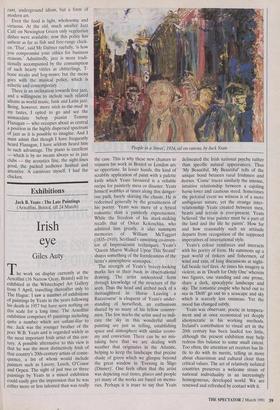Exhibitions
Jack B. Yeats The Late Paintings (Arnolfini, Bristol, till 24 March) Jack B. Yeats The Late Paintings (Arnolfini, Bristol, till 24 March)
Irish eye
Giles Auty
The work on display currently at the Arnolfini (16 Narrow Quay, Bristol) will be exhibited at the Whitechapel Art Gallery from 5 April, travelling thereafter only to The Hague. I saw a number of exhibitions of paintings by Yeats in the years following his death in 1957 but have seen nothing on this scale for a long time. The Arnolfini exhibition comprises 45 paintings including quite a number which are unfam-iliar to me. Jack was the younger brother of the poet W.B. Yeats and is regarded widely as the most important Irish artist of this cen- tury. A possible alternative to this view is that he was the most distinctively Irish of that country's 20th-century artists of conse- quence, a list of whom would include painters such as Lavery, Leech, O'Conor and Orpen. The sight of just two or three paintings by Yeats in a mixed exhibition could easily give the impression that he was either more or less talented than was really 'People in a Street, 1924, oil on canvas, by Jack Yeats the case. This is why these new chances to reassess his work in Bristol or London are so opportune. In lesser hands, the kind of scrabbly application of paint with a palette knife which Yeats favoured is a reliable recipe for painterly mess or disaster. Yeats himself wobbles at times along this danger- ous path, barely skirting the chasm. He is redeemed generally by the genuineness of his poetry. Yeats was more of a lyrical romantic than a painterly expressionist. While the freedom of his mark-making recalls that of Oskar Kokoschka, who admired him greatly, it also summons memories of William McTaggart (1835-1910), Scotland's unwitting co-inven- tor of Impressionist 'techniques. Yeats's 'Queen Maeve Walked Upon This Strand' shares something of the formlessness of the latter's atmospheric seascapes.
The strength of Yeats's breezy-looking marks lies in their basis in observational drawing. The artist understood form through knowledge of the structure of the seen. Thus the head and arched neck of a thoroughbred in 'Horse Leaving a Racecourse' is eloquent of Yeats's under- standing of horseflesh, an enthusiasm shared by so many of his fellow country- men. The few marks the artist used to indi- cate the sky in this wonderful small painting are just as telling, establishing space and atmosphere with similar econo- my and conviction. There can be no mis- taking here that we are dealing with weather that originates in the Atlantic, helping to keep the landscape that precise shade of green which we glimpse beyond the great window in 'Evening in Sligo (Dinner)'. One feels often that the artist was depicting real times, places and people yet many of the works are based on memo- ries. Perhaps it is truer to say that Yeats delineated the Irish national psyche rather than specific natural appearances. Thus 'My Beautiful, My Beautiful' tells of the unique bond betueen rural Irishmen and ,horses. 'Come' traces similarly the intense, intuitive relationship between a cajoling horse-lover and cautious steed. Sometimes the pictorial event we witness is of a more ambiguous nature, yet the strange inter- relationship Yeats created between men, beasts and terrain is ever-present. Yeats believed 'the true painter must be a part of the land and the life he paints'. How far and how reasonably such an attitude departs from recognition of the supposed imperatives of international style.
Yeats's colour reinforces and interacts with his poetry of form. He summons up a past world of tinkers and fishermen, of wind and rain, of long discussions at night- fall beside turf fires. At times his imagery is violent, as in 'Death for Only One' wherein two figures, one standing and one prone, share a dark, apocalyptic landscape and sky. The romantic couple who head out to sea in 'Drift' go out to a seascape and sky which is scarcely less ominous. Yet the mood has changed subtly.
Yeats was observant, poetic in tempera- ment and at once economical yet deeply idiogyncratic in his working methods. Ireland's contribution to visual art in the 20th century has been lauded too little, although the present exhibition may help redress this balance to some small extent. Too often, the attention art receives has lit- tle to do with its merits, telling us more about chauvinism and cultural clout than critical values. The art of relatively isolated countries preserves a welcome strain of national individuality in an increasingly homogeneous, developed world. We are renewed and refreshed by contact with it.


















































 Previous page
Previous page